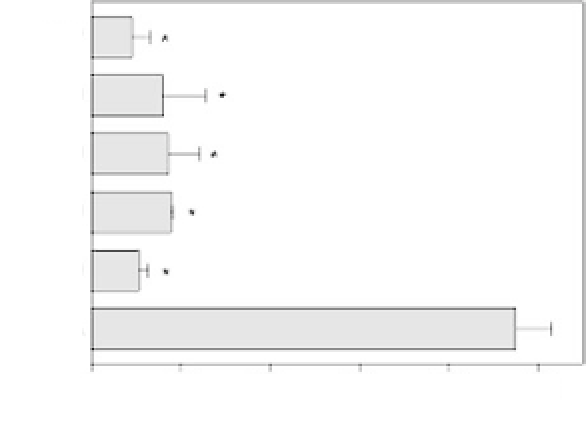Biomedical Engineering Reference
In-Depth Information
DBP
D80
D40
D20
D10
PLGA
0 100 200 300 400 500
(Fibrous capsular thickness (micrometers)
Figure 16.13.
The inflammatory response to PLGA films, DBP hybrid
PLGA films, and DBP. Fibrous wall thickness elicited by PLGA films was
nearly five times that measured for DBP-impregnated PLGA films. *corre-
sponds to
p
<
0.00001 in comparison with PLGAfilms.
contentofDBPscontinuouslyincreasedinPLGAfilms.Thedensityof
inflammatory cells following PLGA film implantation was approxi-
mately two times higher than that following 40% DBP/PLGA films.
The DBP film had fewer inflammatory cells relative to the PLGA
film (Fig. 16.12). PLGA, DBP/PLGA, and DBP films had a notice-
abledifferenceoffibroticbandencapsulation.Thefibroticthickness
was significantly decreased in the DBP/PLGA hybrid and DBP film.
The PLGA film had a five times or more broad fibrotic band than
the other samples (Fig. 16.13). In 40% or 80% DBP/PLGA hybrid
films, macrophages or foreign body giant cells were rarely observed
in immediate contact with the DBP fragment surface, and a thin
collagenousfibrousbandsurroundedthesamples.TheDBPfilmsel-
dom recruited MNGCs compared with PLGA or DBP/PLGA hybrid
films (Fig. 16.14).
These results indicate that the DBP hybrid PLGA film elicits
decreased tissue reactivity that can result from biocompatibility
of DBPs. TNF-
α
plays a role in the inflammatory response that
activates leukocytes, enhances adherence of neutrophils and mono-
cytes,promotesthemigrationofinflammatorycellsintotheintercel-
lularspace,andtriggerslocalproductionofotherpro-inflammatory









Search WWH ::

Custom Search